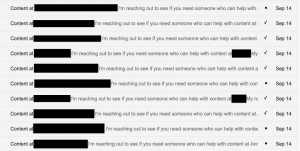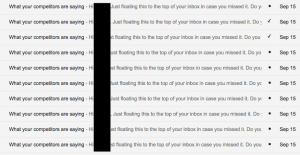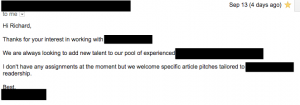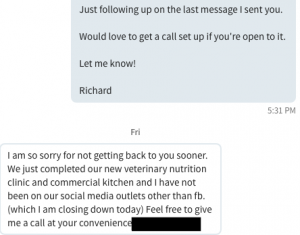In my recent guest post for FreelancerKenya, How I Made $3,558 in My First Month as a Full-Time Freelance Writer, I gave readers the big picture view of the steps I took to build my freelance writing business from scratch.
In today’s post, I’ll take a closer look at one of the most important steps to freelance writing success – prospecting. I’ll also show you the exact process I use to find freelance writing clients.
Now, you may be thinking that we’ve covered prospecting quite extensively here on the blog already – and you’d be right. But time and again budding writers become frustrated with their efforts and give up before seeing tangible results.
This post will help prevent that from happening to you.
It’s not so much about using templates – if you need information on the mechanics of an effective cold pitch, start with Nick’s post on cold email pitching templates. If you’re cold pitching via LinkedIn, take a look at my breakdown of a winning LinkedIn pitch.
Getting Your Prospecting Done
In this post, I’ll focus on the process of getting your prospecting done and how to make sure it’s as effective as possible.
And instead of just telling you what to do, I’ll show you what I’ve done over the past week and share some results.
I focussed on 3 main areas of prospecting over the week – cold emailing businesses, cold emailing magazine editors, and cold pitching on LinkedIn. None of them took me very long to do, but all of them yielded some results.
Read on to find out exactly what I did and the results I got.
Cold Emailing Businesses
The aim of my prospecting efforts this week was to keep a steady stream of leads flowing into my business. If you already have a few clients and are paying your bills you might be tempted to take a break on prospecting, but that’s not the best idea.
According to Ben Settle, one of the worst things a freelancer can do is stop searching for new clients. Think about it, if you want to level up and earn more it makes perfect sense to keep prospecting for new clients. It’s also a great insurance policy against losing an existing client and becoming short on work.
Over the last week I sent 40 cold emails (and followed up with the first batch of 20) to businesses I’d like to work with.
If you’re just starting out I recommend sending at least three times that many in a week. Repeat until you find your first couple of clients before dialling down your efforts. This may sound like a lot, but it shouldn’t take you more than an hour each day.
First things first, make sure you have a good list of prospects to pitch. If you’re not sure of the best way to do this, Ciaran’s article on building a prospect list is a great place to start.
A/B Testing
It’s a good idea to tweak and test your cold pitches to see what brings the best results. This week I decided to test two different email subject lines to see which had the best open rates. To do this I used the free Google Chrome plugin, Email Tracker.
The plugin works with all major email clients including Gmail, Yahoo Mail, and Outlook. it provides a simple way to see if your emails have been opened; read emails will have a check mark next to them in your inbox, unopened emails will have a dot beside them.
Here are screenshots of emails sent with the two subject lines I wanted to test:


As you can see, the subject line I was already using, Content at <company name> , is the clear winner in terms of open rates.
The screenshots show a sample of 10 emails sent with each subject line.
In the sample with the new subject line, What your competitors are saying, only 2 of the emails were opened. In the sample with the old subject line, 6 were opened.
Even after following up with each email using the new subject line, only 5 were opened – and I received zero responses.
So, how did the old subject line – that was recommended by Bamidele Onibalusi during his Earn Your First $1,000 as a Freelance Writer Challenge – perform in comparison?
Of the 20 pitches I sent, 12 were opened and I received 3 replies – and that’s before I’ve had the chance to send out any follow-ups.
Of the replies I got, a couple of people let me know that they produce all their content in-house. But the third response was far more promising. Here’s a screenshot:

After responding to this email I set up a phone call for next week.
So, results from cold emailing businesses: 40 cold emails and 20 follow-ups sent to businesses in my niche: 1 phone call booked.
I’m satisfied with uncovering a warm lead from the 40 clients I emailed, and after following-up using the 3-7-7 formula I could well uncover more leads.
I’m also confident that the subject line I’ve been using is effective. The sample tested was quite small, but I’m happy with the open and response rates I’ve been getting.
Cold Emailing Magazine Editors
I also decided to email the editors of magazines in my niche to see if they need writers.
The names and direct emails of magazine editors are usually quite easy to find, so do some digging on Google and avoid sending to a generic email address that may not be closely monitored e.g. editor@<publication name.com>.
I sent a simple introduction letter to 15 editors during the past week, here’s a screenshot of it:

Of those, I’ve had 5 responses so far. Some editors said they rarely work with freelancers, but a couple of the responses were more encouraging:


Overall I’m very pleased with my results from cold pitching magazine editors over the past week. I also know they’re notoriously busy, so I’ll follow-up a couple more times with those who haven’t responded yet.
LinkedIn Prospecting
You may know that LinkedIn is one of my favourite tools for finding new freelance writing clients. It’s easy to use, full of prospects, and you don’t need to spend hours on it each week to see results.
Over the past week I spent just a few minutes each day prospecting on LinkedIn. This involved connecting with new prospects, sending introduction messages, and following-up.
Once you get into the habit of doing this, LinkedIn prospecting is a great way to keep a trickle of leads coming into your business with very little effort.
My advice is to always try and move the conversation off LinkedIn by asking the prospect if they’d like to set up a quick phone call. You may not like talking to prospects on the phone, but it really will help you land more business.
Here are a couple of responses from people I’ve pitched over the last week:


Wrapping Up
Cold pitching does take some time, but it definitely delivers results if you’re patient and persistent. If you’re starting out as a freelance writer you’ll need to pitch a lot – there’s just no getting around the fact!
But even for more established writers, it’s worth making prospecting a regular part of your routine.
And don’t worry that you’ll pick up too much work and won’t be able to deliver. That’s a great situation to be in. Why? Because then you have the chance to pick and choose who you work with – and also command higher rates!
So, set aside some time each day to get your prospecting done. You’ll be glad you did.
Do you have any questions about freelance writing? Visit our Start Here page for a ton of resources to help you out.




Wow, how do you manage to do your pitching so quickly. Mine never takes a few minutes.
Do you have a post of how to prospect via LinkedIn?
Thanks for sharing. I look forward to my writing work picking up.
Hi Shoshanah,
I prefer to work the numbers rather than personlise my pitches too much for each prospect. Here’s a breakdown of the pitch I use for LinkedIn: https://writeworldwide.com/winning-linkedin-pitch/. As you can see, the name and company name can be edited quickly so I can send a lot of these in a short time. Give it a go and let me know how you get on!